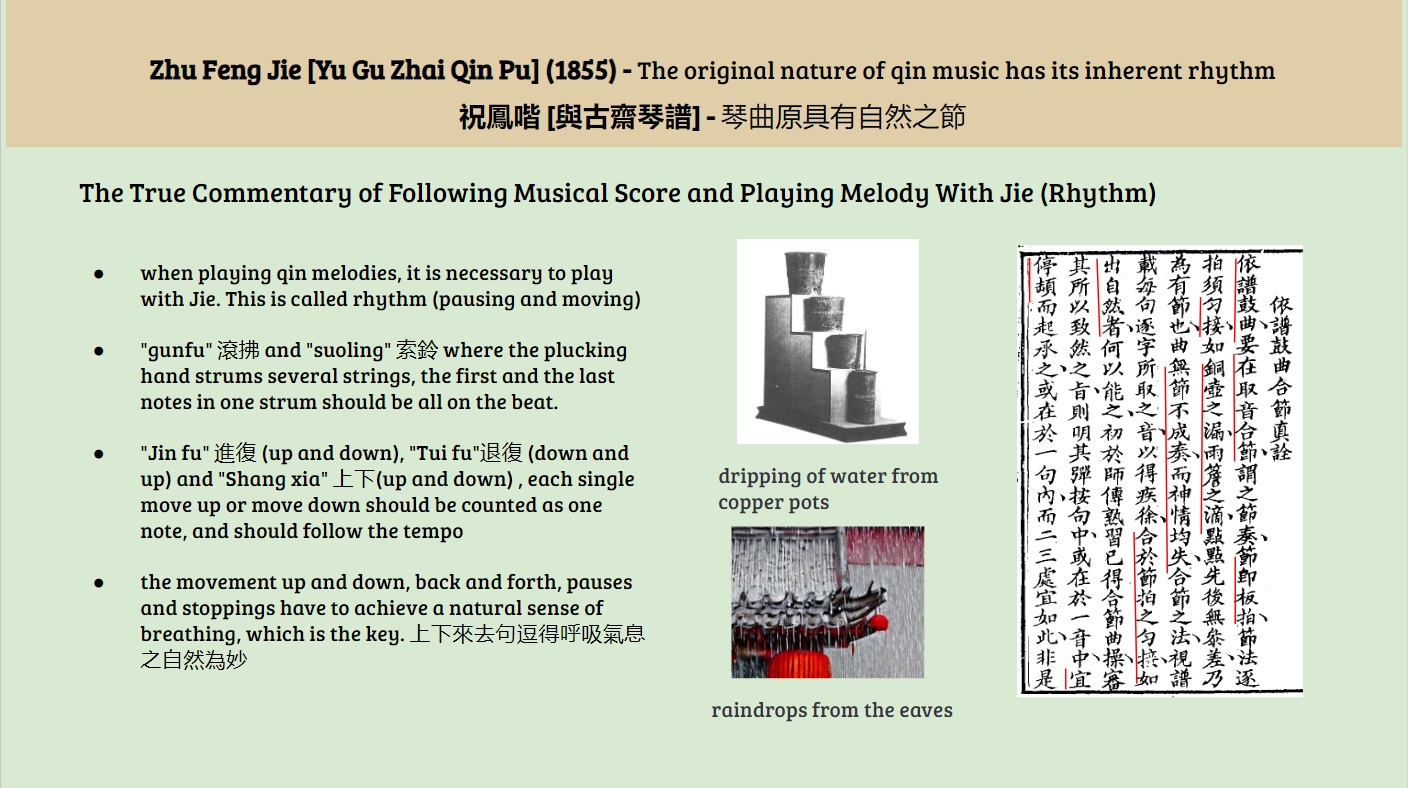|
Translated by Peiyou Chang The original nature of qin music has its inherent rhythm. When first attempting to play according to the notation, it is not easy to achieve a complete performance. Through repeated practice and familiarity, the rhythm gradually becomes harmonious and eventually reaches a state of profound beauty. This process relies on the individual. The term 'rhythm' refers to the beat, as mentioned in the 'Guoyu,' which states, 'Wood is to be beaten in rhythm.' If the notation of qin music lacks an indication of beat, it may be due to the fear of becoming rigid and losing the spiritual transformation. However, for beginners, it is important to grasp the rhythm before anything else. Nevertheless, even in the realm of spiritual transformation, it is invariably achieved through rhythm. The sound of qin music is formed by the measurement of length, shortness, slowness, and swiftness, and it is through beats that these measurements are divided. When a sound emerges, it is immediately marked by a beat; this is called the 'head beat.' While the sound is still present and has not ceased, the beat falls at an appropriate moment within it; this is called the 'waist beat.' When the sound has just ceased, the beat is struck; this is called the 'tail beat.' This refers to the method of dividing the beats into the beginning, middle, and end based on a single sound. Furthermore, there is the additional beat after the sound has ceased, known as the 'interlude beat.' It is necessary to wait for the sound of the previous beat to pass and then resume with the subsequent sound. This creates beats without sounds. In the composition, there are often one or two interlude beats at the end of a phrase, allowing a brief pause before swiftly continuing the performance, enabling the expression of the head beat and facilitating a smooth breath. Additionally, there is the practice of relaxing and slowing down the beat during a sustained sound, known as the 'slow beat,' and accelerating the beat when approaching the end of a sound, known as the 'tense beat.' All of these naturally occur as the composition progresses, following a natural and rhythmic pattern. The proper execution of both fast and slow beats is essential to maintain a consistent rhythm, which is referred to as 'tempo.' In qin music, there are single or double notes, or even three or five notes, played on the same string or different strings, repeated several times. Although the sounds may seem complex, they are the result of accumulating breath and energy between the preceding and succeeding notes. It is necessary to differentiate between the slow and fast within this, in order to match the rhythm. When first attempting, careful listening is required to achieve harmony. The method lies in distinguishing the sequence of lightness and heaviness, speed and slowness, as well as the continuation and connection between several sounds. flexibly retain your playing within the continuity, breaks, pauses, and transitions of the musical phrases. Overall, the movement up and down, back and forth, pauses and stoppings have to achieve a natural sense of breathing, which is the key. The True Commentary of Following Musical Score and Playing Melody With Jie (Rhythm) 依譜鼓曲合節真詮 To produce sound from a piece of music, it must align with the beat. The beat should flow smoothly, akin to water dripping from copper pots or raindrops falling from eaves without overlap. This rhythmic flow is the tempo, where no single beat rushes to take the place of the next one. Without the proper tempo, a musical performance will not be complete, lacking emotion and spirit. How does one achieve the proper tempo? Initially, through learning from a teacher, one grasps where to make pauses, how to connect notes seamlessly, and how to play in one continuous breath. The guqin vibrato "yin" and "nao" resemble elongating a note, akin to vocal prolongation while singing. The "dou" technique in guqin involves creating a second sound with the left hand after the initial plucking sound, akin to a short and quick vibrato sound emanating from a singer's throat. The "zhuang" technique in guqin is similar to "dou" but with a different moving direction of the left hand. On the other hand, "huan" technique in guqin is also akin to "dou" but occurs simultaneously with the right hand's plucking sound. "Huan" creates a brighter and stronger tone, followed by a darker and lighter tone. For techniques like "gunfu" and "suoling," where the right hand strums several strings, the first and the last notes in one strum should both be on the beat. Techniques like "Jinfu" (up and down), "Tuifu" (down and up), and "Shangxia" (up and down), each single move up or down should be counted as one note and should follow the tempo. Usually, when starting a piece, the tempo is slow, as if entering gradually. The ending also slows down (similar to the Italian music term "Ritardando"). If a qin player can sing the melody with the right tempo, their spirit and emotion will easily find the proper feeling and elevate to a higher level of mind. It is not necessary to play a fast tempo melody, but when playing a slow tempo melody, the player should use a variety of slow, tight, and controlled beats. Whether the tempo is faster or slower, it should still remain within the proper tempo. When playing slowly, the player's emotions remain coherent, and they don't feel loose. When playing fast, the player keeps their mind concentrated, without suddenly losing control. This is acknowledged as a good result. Original Chinese text: 琴曲原具有自然之節,初試照譜彈,未易得成奏,習熟乃合節,漸至於神妙,此則存乎人。節即是板拍,《國語》所謂,“木以節之”也。琴曲譜不定板拍者,恐因定 固執而失入神化,非為初學者之但得其節奏而己也。然至入神化,亦莫不由於節奏而致矣。 夫琴曲之音,因分長短緩急之度而成奏,拍即節其度之所以分也。有於音 初出之際即拍,曰頭板。於音已出未歇,適其中際而拍之,曰腰板。於音剛歇之際即拍,曰底板。是則於一音而分初中末三者之拍法也。又有於音已歇後再拍,曰閒板,須待其板聲已過,再接出其下之音,此無音而有拍也。曲中句末多一二閒板者,免緊接下音,而急促其奏,俾得展頭板,以舒其呼吸。更有於音宜舒轉而放慢拍 之,曰慢板;於音宜結束,而催緊拍之,曰緊板。皆由曲奏至此際,必爾而以成,亦自然而然者矣。其緊慢之板,均必得勻拍,總謂之節奏。 琴 曲有一二音,或三五音,於同弦或各弦,而作數次者,音雖似繁複,為前後氣蓄,必如是乃成。須於此中分緩急,以合其節奏。初試細審聽,應如何得合,法在分別輕重疾徐之先後,與分幾聲之續上,幾聲之接下,得靈活留蓄於其連斷頓挫之間,總以上下來去句讀,得呼吸氣息之自然為妙。總以上下來去句讀,得呼吸氣息之自然為妙。
| |||||||
